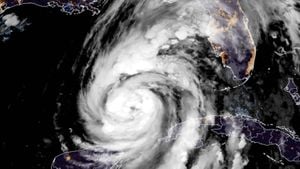In the far reaches of our solar system, a celestial dance between a dwarf planet and its tiny moon has unveiled secrets buried deep beneath ice and rock. The dwarf planet Eris, a distant and enigmatic member of the Kuiper Belt, and its moon Dysnomia have provided scientists with a fascinating glimpse into the early and ongoing processes shaping these distant worlds.
Eris and Dysnomia have stunned astronomers with their unique relationship. Much like Pluto and its moon Charon, Eris is tidally locked with Dysnomia; meaning, they exhibit a synchronized dance where one face of each body constantly faces the other. However, unlike Earth’s moon, which has yet to cause such a tidal locking, the connection between Eris and Dysnomia offers an unexpected insight into the internal workings of dwarf planets.
In a recent study by planetary scientists Nimmo and Brown, published in Science Advances, a closer examination reveals Eris's inner secrets. For Eris to be tidally locked with Dysnomia, it must possess peculiar characteristics that make its interior much more dissipative, able to absorb and redistribute gravitational energy more effectively than its larger kin, Pluto. Using data from the Atacama Large Millimeter/submillimeter Array (ALMA), the researchers explored how Eris's interior has evolved and what makes it tick.
To understand why these findings are groundbreaking, one must appreciate the complications of tidal locking. Earth's rotation, for example, has been slowing due to the tidal forces exerted by the moon, but it remains far from being tidally locked. In contrast, Eris achieved this state with Dysnomia remarkably quicker. This phenomenon suggests a different evolutionary pathway, hinting at an initially molten interior that has not entirely solidified over time.
Imagine, for a moment, the difficulty of walking on ice-covered lakes. On the surface, everything seems solid and unyielding. However, should that ice be thin or the lake underneath somewhat warm, your steps might crack through, revealing slush or water below. Eris's shell might be similarly deceptive; a thin, convecting ice crust enveloping a possibly warm or even slushy interior. Such conditions would allow it to absorb tidal forces much more effectively than a completely solid body would, explaining its surprising ability to synchronize its rotation with Dysnomia’s orbit.
Historically, planetary scientists have speculated about the internal structures of distant dwarf planets, often with more questions than answers. Pluto, for example, with its unique features like the heart-shaped basin Sputnik Planitia, has challenged scientists to rethink planetary geology at the fringes of our solar system. Eris, now showing even more distinct characteristics from its sibling despite apparent surface similarities, encourages further intrigue and study.
The study's methodology was meticulous. The team modeled the tidal and thermal evolution of Eris’s interior, taking into account the latest Eris-Dysnomia mass ratio obtained through ALMA observations. This advanced observatory has allowed them to peek beneath the icy veneer, measuring densities and masses with unprecedented precision. The results were nothing short of illuminating: Eris's interior must be highly dissipative, suggesting it may have melted significantly early in its history and still maintains a convective, warm ice interior today.
But the compelling story does not end there. Unlike Pluto's conductive ice shell, Eris's outer layer appears to be convecting, meaning it transports heat differently from within. This convective motion could stem from a lower presence of volatile compounds like methane or ammonia in Eris, possibly stripped away during the energetic impact that formed Dysnomia. These compositional differences likely contribute to Eris's higher density and set it apart from Pluto in more ways than one.
“Even considering the most conservative assumptions, the answer is that Eris is very dissipative—more so than should be the case for a body that’s frozen solid the whole way through,” the researchers noted. This highly dissipative nature points to an exciting possibility: Eris could harbor a subsurface ocean, a feature that significantly recasts our understanding of these distant ice worlds.
The implications of Eris’s oddly warm interior are vast. If a subsurface ocean exists, it would necessitate ongoing geological activity. Such a scenario could mirror similar findings on moons closer to home, like Europa or Enceladus, which are known for their hidden, liquid oceans beneath icy shells. These findings dramatically expand the scope of potential astrobiological habitats in our solar system, pushing the frontier of where life might exist.
Nevertheless, caution is warranted. The exact nature of Eris’s interior remains speculative without direct sampling or more detailed observations. The current models provide a compelling picture but are founded on assumptions that must be validated through future missions or advanced remote sensing technologies. The James Webb Space Telescope (JWST), for instance, has already provided preliminary observations suggesting the presence of less stable, more recent compounds on Eris’s surface, urging further exploration.
Future research will undoubtedly aim to decipher when Dysnomia’s orbit circularized and how its thermal state evolved over geological timescales. Understanding these dynamics can illuminate the timeline of Eris’s thermal and structural evolution, perhaps revealing more surprises about our solar system's frontier worlds. As astronomers continue to probe the Kuiper Belt, each discovery peels back another layer of the complex and diverse evolutionary history of these distant objects.
The research into Eris and Dysnomia not only enriches our knowledge of these specific bodies but also broader planetary processes. For instance, the differential erosion and compositional dynamics observed between Eris and Pluto could shed light on the general processes that govern planetary formation and evolution. Such studies will help refine models and theories that apply far beyond our solar neighborhood, potentially offering insights into exoplanetary systems orbiting distant stars.
As our technological prowess grows, so too does our ability to unravel the mysteries of the cosmic dance that celestial bodies perform. While Eris and Dysnomia’s story is still being written, it serves as a powerful reminder of the intricate and interconnected nature of our universe. The secrets harbored beneath an icy shell, millions of miles away, echo the fundamental questions of planetary science and the ceaseless human quest for knowledge.
In the words of the researchers, “Eris must have melted significantly early in its evolution and must still host a warm convective ice interior. A subsurface ocean, similar to that which has been proposed for Pluto, is not required by the model, but is one of the scenarios that is now a very plausible explanation for what’s lurking under Eris’s surface—a possible ocean world 90 times further from the Sun than the Earth is!” This tantalizing possibility of distant ocean worlds continues to inspire scientists and captivate the public imagination.



